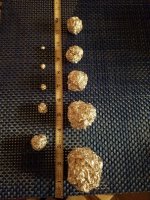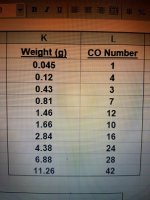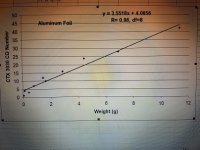LawrencetheMDer
Hero Member
- Feb 22, 2014
- 984
- 2,397
- 🏆 Honorable Mentions:
- 2
- Detector(s) used
-
Minelab Manticore, Minelab CTX3030 w 11" and 17" DD coils,
Minelab Excalibur II w 10" coil, Equinox 800 (4) w 11" and 15" coils,
Troy Shadow x2 w 7" coil, Pointers; Garrett Carrot, Pro Find 35,
- Primary Interest:
- Beach & Shallow Water Hunting
Recently on TreasureNet, I showed that there was a very close relation between lead weight and CTX 3030 CO number; as lead weight increases so does CO number on the CTX 3030. In the present Blog, I show the very close relation between aluminum foil weight and CTX 3030 CO number.
I took varying amounts of aluminum foil, from about 1/2 gram to over 11 grams, and rolled each up in a ball. Picture 1 shows the aluminum foil balls used in the current study. The 11g ball (not shown) was composed of the 2 largest foil balls to expand the range of weight.

The Table shows the weight of each ball in grams(g) and the corresponding CO number as found on an air test at about 1" from the coil. [FE numbers were stable at 11 or 12.] The lowest foil ball at 0.4 grams failed to provide a reliable CO response, most probably because it was rolled-up in a ball; I have found to many to count small pieces of foil with the CTX 3030 with stable CO numbers, typically 01 or 02, with weights almost too small to measure and typically not rolled up to a small ball. Due to the unreliable responses at 0.4g, the analysis was based on the 10 largest weights.

The graph shows the very close relation between aluminum foil weight and CO number; a correlation of 0.98 shows that almost all the change in CO number for the objects can be attributed to weight. The highly linear relation between foil weight and CO number breaks-down at lower foil weights, under 0.4 grams, and at the higher weights greater than about 12 grams. For a large range of foil target weights, however, CTX 3030 CO number represents target weight.

It is clear that weight and size vary at the same time; as weight increases so does size as clearly evident in the picture. So it is possible that CO number might vary with target size, irrespective of weight. I am currently working on addressing this issue.
In a previous Blog I showed that there was a close relation between lead (sinker) weight and CO number; as lead weight increases so does the CTX 3030 CO number from CO of 12 to 43. In the present Blog I show that that is a very strong relation between aluminum foil weight and CTX 3030 CO number; as foil weight increases from 0.45g to over 11 g the CO number increased from 01 to 42. A very interesting observation of the 2 studies combined reveal that something else is also helping to drive the CO number findings (possibly size). The lead weights ranged from 12g to 120g. In the foil study, the foil weights were from 0.45g to about 11g. If the CTX didn't capitalize on additional (as yet unknown) information, the foil weights would have been too small to yield a range of CO numbers from 01 to 43. Based on lead weight study alone, the foil balls shouldn't have yielded a CO greater than 24 or so (where lead weight and foil weight ranges overlap).
The results of the lead weight and aluminum foil studies show a strong relation between target weight and CO number. These results help to explain why lead (fishing) weights as well as why aluminum foil can be seem at such a large range of CO numbers on the CTX 3030. The real take-home message of these 2 studies is that lead and foil can appear at any CO number on the CTX 3030, a common observation when using the CTX 3030.
My real interest in performing these studies is to better understand where along the CO axis gold might be hiding. In this regard, the results should provide a warning to users of the CTX 3030 that valuable targets, such as gold, can appear anywhere along the CO axis from 1 - 50, primarily depending on weight. Ignoring CO numbers that typically correspond to junk such as foil at 12:01-03 and 12:15-23 may lead one to miss gold rings that can ring-up anywhere along the CO axis. If you don't want to miss gold, the results suggest that you dig all good (i.e., FE of 12, range of 9-15) targets irrespective of CO number.
I took varying amounts of aluminum foil, from about 1/2 gram to over 11 grams, and rolled each up in a ball. Picture 1 shows the aluminum foil balls used in the current study. The 11g ball (not shown) was composed of the 2 largest foil balls to expand the range of weight.

The Table shows the weight of each ball in grams(g) and the corresponding CO number as found on an air test at about 1" from the coil. [FE numbers were stable at 11 or 12.] The lowest foil ball at 0.4 grams failed to provide a reliable CO response, most probably because it was rolled-up in a ball; I have found to many to count small pieces of foil with the CTX 3030 with stable CO numbers, typically 01 or 02, with weights almost too small to measure and typically not rolled up to a small ball. Due to the unreliable responses at 0.4g, the analysis was based on the 10 largest weights.

The graph shows the very close relation between aluminum foil weight and CO number; a correlation of 0.98 shows that almost all the change in CO number for the objects can be attributed to weight. The highly linear relation between foil weight and CO number breaks-down at lower foil weights, under 0.4 grams, and at the higher weights greater than about 12 grams. For a large range of foil target weights, however, CTX 3030 CO number represents target weight.

It is clear that weight and size vary at the same time; as weight increases so does size as clearly evident in the picture. So it is possible that CO number might vary with target size, irrespective of weight. I am currently working on addressing this issue.
In a previous Blog I showed that there was a close relation between lead (sinker) weight and CO number; as lead weight increases so does the CTX 3030 CO number from CO of 12 to 43. In the present Blog I show that that is a very strong relation between aluminum foil weight and CTX 3030 CO number; as foil weight increases from 0.45g to over 11 g the CO number increased from 01 to 42. A very interesting observation of the 2 studies combined reveal that something else is also helping to drive the CO number findings (possibly size). The lead weights ranged from 12g to 120g. In the foil study, the foil weights were from 0.45g to about 11g. If the CTX didn't capitalize on additional (as yet unknown) information, the foil weights would have been too small to yield a range of CO numbers from 01 to 43. Based on lead weight study alone, the foil balls shouldn't have yielded a CO greater than 24 or so (where lead weight and foil weight ranges overlap).
The results of the lead weight and aluminum foil studies show a strong relation between target weight and CO number. These results help to explain why lead (fishing) weights as well as why aluminum foil can be seem at such a large range of CO numbers on the CTX 3030. The real take-home message of these 2 studies is that lead and foil can appear at any CO number on the CTX 3030, a common observation when using the CTX 3030.
My real interest in performing these studies is to better understand where along the CO axis gold might be hiding. In this regard, the results should provide a warning to users of the CTX 3030 that valuable targets, such as gold, can appear anywhere along the CO axis from 1 - 50, primarily depending on weight. Ignoring CO numbers that typically correspond to junk such as foil at 12:01-03 and 12:15-23 may lead one to miss gold rings that can ring-up anywhere along the CO axis. If you don't want to miss gold, the results suggest that you dig all good (i.e., FE of 12, range of 9-15) targets irrespective of CO number.
Amazon Forum Fav 👍
Upvote
0


 how do the numbers change ??
how do the numbers change ??
